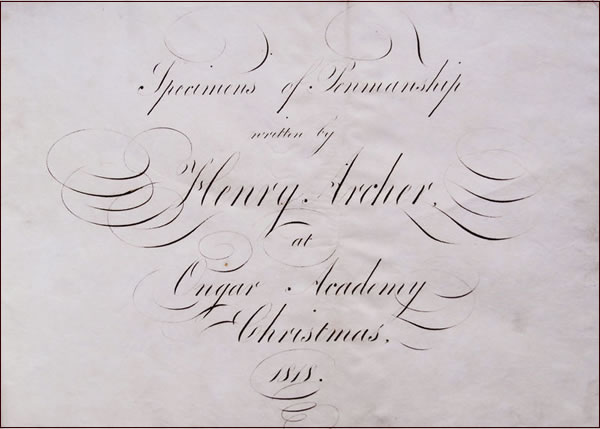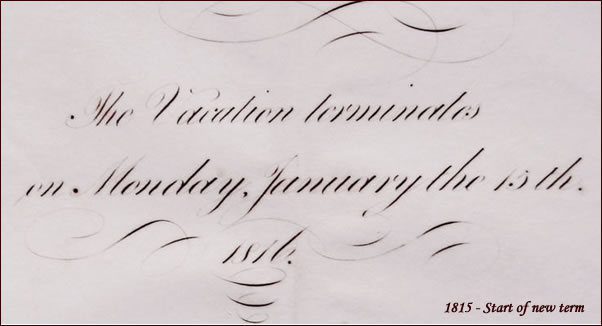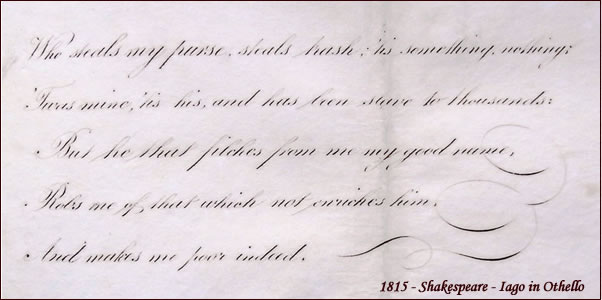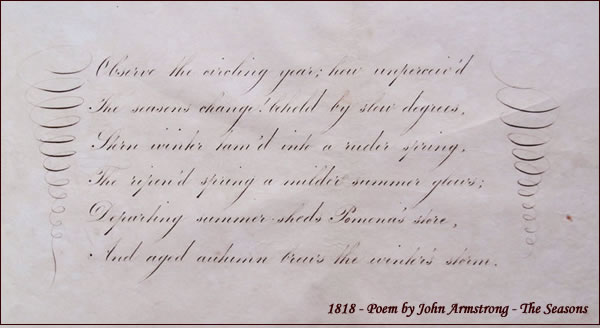My interest in family history was first awakened many years ago while I was still a teenager, when my grandfather told me that as a child he had lived for some time in Epping with his grandparents. From census returns and BMD records I believe this to have been when his mother was widowed in 1876, at which time Grandad would have been 9 years old. I remember that he mentioned that he had found it strange that his grandmother always addressed and spoke of her husband by his surname.
He showed me two school work books in which his maternal grandfather, Henry Archer, whom I now know to have been born in Chipping Ongar in 1804, had written specimens of copperplate handwriting. These were dated Christmas 1815 and Christmas 1818, and may well have been intended to be taken home to Henry’s parents as a report on his progress.
This idea is supported by the 1815 work book containing a note about the date of the end of the vacation, though the later one had no such note; by 1818 Henry would have been 14 years of age and had very likely finished school by then to take up an apprenticeship as a harnessmaker.

He appears on the 1841 census as practising that trade in Epping (less than 10 miles from Chipping Ongar), later adding the skills of a saddler and collarmaker, and continued to live there until his death in 1887.
When Grandad died, I was asked what memento of him I would like to have, and chose the work books. They were in poor condition, though still retaining the tissue sheets separating the pages, which has mostly preserved them from foxing. I have had them professionally restored and they are now kept in a special folder which the restorer made to hold them.
The Victoria County History of Essex (1) has an article on schools in Chipping Ongar which includes an account of the academy which begins “The most important private school in the town was Ongar Grammar School, said to have been founded in 1811 by William Stokes M.A”. It mentions among many other things that in 1845 it was known as Ongar Academy and also that the school closed in about 1940.

The cautious wording of the italicised passage in the last paragraph is justified by a much more detailed study of the life and times of the first master, Richard Stokes (2). This states that he, Richard, was the founder of the academy, and quotes as evidence an advertisement which he placed in the Chelmsford Chronicle of 11th January 1811 (2a).
Relating that Richard’s father, Jonathan Stokes, a farmer at High Ongar, had recently died and left him £200, as well as a share of the residue of the estate. The author suggests that this legacy might well have prompted Richard to set up his own school. The article mentions that Richard paid particular attention to penmanship, and describes a similar ‘Specimens of Penmanship’ work book produced by one John Shipman in 1818, preserved at Essex Record Office (2b).
This, like the one of 1815 by Henry Archer, has a note of the end date of the vacation, which as suggested above might imply that Shipman was due to return to continue his education. The author offers an additional possible explanation, namely that the production of the booklets was a holiday task. One historian of handwriting has explained how, in some schools, the learning of handwriting was at that date regarded not only as of practical value, but also as a character building activity in its own right (4).

Perhaps this was the case with the academy – the existence of these work books certainly suggests that its importance was appreciated. The choice of items to be written also seems to have been influenced by a desire to acquaint the boys with good advice, though no explicitly religious exhortations were included.
I was somewhat surprised (and delighted, needless to say) to find a snippet from an auction catalogue (3) on Google Books describing yet another such item which had survived, also written by Henry Archer, in 1812. So it seems that my great great grandfather must have been one of the academy’s very first pupils, from the age of 7 or 8.

On contacting the auction house, I have learned that the work book failed to sell in 1992. I am trying to contact the intending vendor, with kind assistance from the firm’s Managing Director, in the hope of discovering its present whereabouts, but unfortunately the trail seems now to have become cold.
Roger in Sussex
© Roger in Sussex 2008<
SOURCES
- A history of the County of Essex Volume 4. Pages 169-171. Online at Chipping Ongar – Schools | British History Online
2. “The life and times of a rural schoolmaster: Richard Stokes of Ongar Academy.”
Williams, I. L.
Essex Archaeology & History, 3rd. series, 29 (1998), 145-54.
ISSN 03083462
2a. Essex Record Office (ERO T/B 171/15)
2b. Essex Record Office (ERO D/DU 276/8)
- Catalogue by Bloomsbury Book Auctions – 1992 Page 54.
Archer (Henry) Specimens of Penmanship . . ., calligraphic manuscript on 6 leaves original wrappers. Chipping Ongar Academy, 1812
4.Ewan Clayton – A history of learning to write. Online at: http://www.ejf.org.uk/Resources/ejhandw.pdf